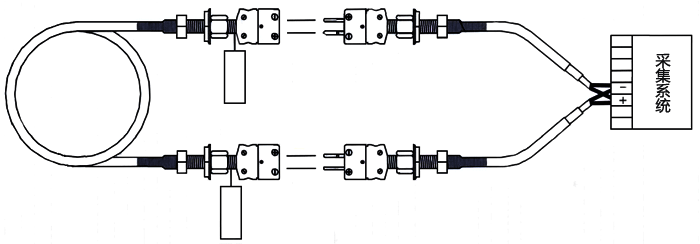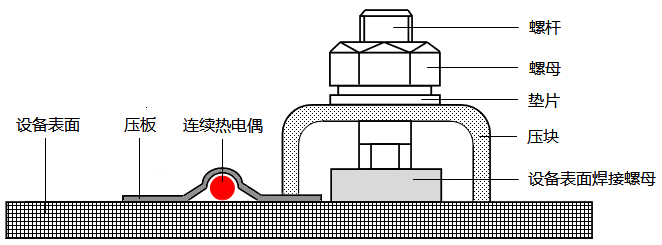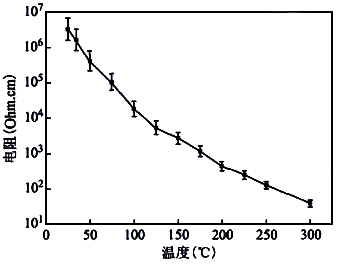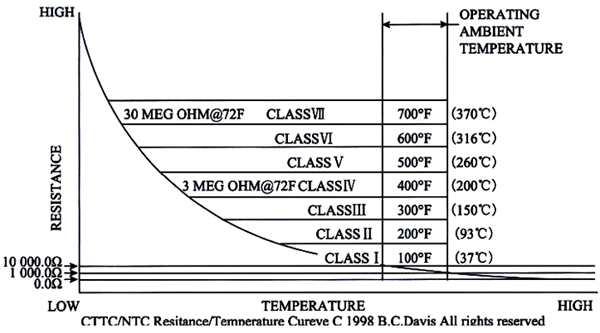 Application of hot spot detector in surface temperature measurement of gasifier
Application of hot spot detector in surface temperature measurement of gasifierThe gasifier with coal and oxygen as raw materials for gasification reaction is a pressure vessel, and the normal temperature in the furnace is about 1300 ℃, or even more than 1500 ℃. The furnace bricks lined in the furnace will be melted at high temperature, and the refractory bricks will become thinner due to the erosion of hot gas and slag. In some cases, such as defects during bricklaying, furnace bricks will fall down, or hot gas will invade through the brick joints. Thinning or even falling off of refractory bricks in the furnace or hot gas invading through the brick gap will increase the surface temperature of the gasifier wall, reduce the strength of the pressurized metal shell of the gasifier, and rapidly reduce the allowable stress, resulting in unsafe equipment, which will lead to safety accidents. Therefore, it is required to measure the surface temperature of the gasifier in real time and give an alarm. Another purpose of measuring the surface temperature of the gasifier is that the surface temperature of the gasifier reflects the degree of thinning of the refractory bricks in the furnace, and the time for replacing the refractory bricks can be determined in advance.
The surface temperature measurement system of the gasifier is designed to lay temperature measuring elements on the vessel shell of the gasifier for operation. The temperature measuring element is a linear hot spot detector that can detect the highest temperature on a continuous route. It can continuously generate a millivolt signal corresponding to the highest temperature in the laying area, convert and transmit this signal to DCS to monitor the location where the highest temperature occurs. The difference between the hot spot detector produced by Weilian Electronics and the ordinary thermocouple is that its hot contact is not fixed, but always corresponds to the highest temperature on the cable. If the hot spot detector is reasonably laid on one surface, the temperature reflected by the temperature measuring cable can be regarded as the highest temperature on the surface it reaches.
Operating principle of hot spot detector
The basic working principle of hot spot detector is thermoelectric effect.
The thermoelectric effect was discovered by the German scientist Seebeck in 1821: conductor A and conductor B of two different materials are welded together head and tail to form a closed loop. These two welding points are called reference points and hot contacts. When there is a temperature difference between the reference point and the hot contact, this closed loop will generate a thermal potential. The size of thermoelectric potential is only related to the temperature of reference point and hot junction; This phenomenon is called thermoelectric effect. Ordinary thermocouples work on this principle.
The hot spot detector is filled with NTC thermal sensitive material, a semiconductor thermal sensitive material with large negative temperature coefficient. This material has high resistance at room temperature and low resistance when heated.
When the temperature of any point (T1) on the hot spot detector is higher than the temperature of other parts, the insulation resistance (R) between the thermocouple wires at this point decreases, resulting in a "temporary" hot contact, which is equivalent to the metal hot contact of the point thermocouple, and acts the same as the hot contact of the ordinary thermocouple, as shown in Figure 1.

当热点探测器上另外一点(T2)的温度高于(T1)点时,该处的热电偶导线之间的绝缘电阻会变的更低,从而出现新的“临时”热接点,如图2所示。

The maintenance hot spot detector is made of NTC thermal sensitive material, and the resistance of this material can change obviously with the change of temperature; At the same time, with advanced production technology, the product always outputs the temperature signal corresponding to the highest temperature of the paved area. The temperature measurement performance is superior, which can effectively sense the subtle changes of temperature along the hot spot detector, and has excellent hot spot capture capability.
Implementation of gasifier surface temperature measurement system
There are 6 gasifiers in the gasification hydrogen production unit (represented by A, B and C respectively). In order to truly and accurately detect the temperature of each area on the surface of the gasifier, the system uses the concept of temperature zone (the area detected by a single hot spot detector) to divide each furnace into 32 temperature zones. For each temperature zone, the hot spot detector with the best temperature level is selected to achieve the best monitoring of the surface temperature of the gasifier.
Intrinsically safe temperature acquisition system is selected as the temperature acquisition system. Each gasifier is equipped with a set of temperature acquisition system, which is connected to the respective DCS system of each gasifier. Each set of acquisition system includes 1 motherboard, 2 power modules, 2 gateway modules and 9 temperature input modules, among which 1 temperature input module is used for ambient temperature compensation. Each set of temperature acquisition system collects 32 channel hot spot detector signals.
The complete set of intrinsically safe temperature acquisition system is placed in the field protection junction box. Each set of temperature acquisition system uses two block couplers to achieve redundancy of communication.
1. Connection method of hot spot detector
The maintenance hot spot detector adopts the redundancy design of connection at both ends to increase the reliability of the equipment. It is connected to the temperature acquisition system through high temperature resistant compensation wire. The installation diagram of the hot spot detector is shown in Figure 3.
Installation diagram of hot spot detector

2. Installation of hot spot detector on gasifier
This project involves 6 gasifiers with a diameter of Φ 3.2m。 32 temperature zones are set on the outer surface of each gasifier, including 8 temperature zones on the vault in four quadrants and 24 temperature zones on the cylinder. A total of 32 hot spot detectors are used to monitor the surface temperature of the gasifier.
Fixings of hot spot detector are provided by the supplier, which are divided into reinforcement fixture and pressing plate, which are protective layers. During the design of the gasifier body, the temperature detection points on the furnace wall surface shall be arranged as required, and the positions for fixing the pre weldment nuts shall be drawn. The manufacturer shall weld the pre weldment nuts on the furnace wall during the manufacture of pressure vessels. Each furnace uses about 2800 fixing nuts with M6 specification. During installation, the pressing plate shall be coated with filler to make better contact with the hot spot detector and facilitate the element to cling to the furnace wall.
Fixation of hot spot detector on equipment surface

The hot spot detector is laid from the top to the bottom of the gasifier according to the layout plan, and covers the surface of the gasifier 360 °. Weld the nut on the surface of the vessel according to the layout drawing, and fix the hot spot detector with a special fixing fixture to ensure good contact between the hot spot detector and the furnace surface. The high temperature resistant glass fiber tape pasted on the inner side of the pressing plate can not only make the hot spot detector contact the furnace wall well, but also effectively delay the temperature loss in the area where the hot spot detector reaches, so that the hot spot detector can more truly reflect the maximum temperature of the measured area.
The hot spot detector at the vault of the gasifier shall be fixed with an arc pressing plate. The spherical space between two adjacent circles of the vault is 150 mm, and the space between two adjacent nuts is 200 mm.
The hot spot detectors on the cylinder of the gasifier are installed vertically and fixed with straight pressing plates. The spherical space between two adjacent circles of the cylinder is 200mm, and the space between two adjacent nuts is 150mm.
The hot spot detector is connected with the compensation wire through a complete set of ceramic connectors, which are placed in the stainless steel junction box for protection. The other end of the compensation wire is connected to the temperature acquisition system through pipe or cable tray. The temperature acquisition system is connected to the DCS system of the whole plant to realize the real-time monitoring of the surface temperature of the gasifier.
3. Signal acquisition system
The signal acquisition product is a perfect combination of remote I/O technology, safety barrier technology and field bus technology. It is a new type of bus component that can be directly placed in the hazardous 1/2 zone to connect intrinsically safe switching or analog field devices.
The system is composed of motherboard, power module, gateway module and I/O module plugged in it. The motherboard plays the role of distributing power, transmitting data and connecting field devices. The power module provides sufficient power supply for the normal operation of the system. The redundant configuration of the power module ensures the reliability of the power supply of the whole system. The gateway module controls the data communication between the I/O module and the control system. It shoulders the dual tasks of master and slave equipment, and the redundant configuration of gateway module ensures the reliability of system data communication.
As the interface of peripheral equipment, I/O module handles the input/output signals of field equipment with EExia IIC explosion-proof grade. The motherboard can plug 16 I/O modules at most, and the power supply of the modules is provided by the motherboard without external power supply. All modules can be simply plugged and unplugged by hand without any tools. After the system is connected internally, the peripheral components can be connected.
The PROFIBUS-DP address of the system is set by three knobs on the motherboard, and the maximum number of addresses is 125. If there are more than 32 nodes connected to a network, it is necessary to divide the network into several network segments through repeaters and/or segment couplers. The segment coupler can isolate the common PROFIBUS-DP bus RS485 into two intrinsically safe PROFIBUS segments for peer-to-peer communication, with the communication rate range of 9.6-1.5Mbps.
Advantages of hot spot detector
1. Excellent material properties
The hot spot detector adopts advanced NTC thermosensitive material composition, and its resistance can change dramatically with temperature. The temperature performance test diagram is shown in Figure 4.

When NTC thermal sensitive material filled in the hot spot detector is at normal temperature (or low temperature section), the resistance value is above megaohm; As the temperature rises, the resistance decreases rapidly. At high temperature, it can be reduced to the resistance range equivalent to that of metal, which is conducive to the formation of "temporary" hot contacts and has strong ability to capture hot spots. At the same time, the NTC thermistor constant deviation is small, the detection accuracy is excellent, and the consistency is strong. In the actual use process, the performance is very stable and reliable.
2. Advanced process - unique grading technology
The temperature of different parts of the gasifier body surface (such as the vault, the furnace body straight tube section, and the short nozzle section) is different; In addition, the surface temperature of the gasifier varies greatly with the furnace type and pressure. In order to carry out more precise monitoring of different temperature ranges on the surface of the gasifier, the proportion of NTC insulation materials was adjusted according to the new characteristics of hot spot detector materials and years of experience, and the classification technology was first used on the hot spot detector. Each level has an optimal operating temperature range to maximize its performance and greatly enhance the "hot spot" detection capability.
The classification method and principle are described as follows:
① The operating temperature range of the hot spot detector is - 40~900 ℃. NTC insulation material has high resistance at room temperature (or low temperature), but its resistance value decreases exponentially with the increase of temperature. The resistance ranges from megohm to ohm.
② Within the temperature range of - 40~900 ℃, the hot spot detectors are divided into seven grades. The resistance value of NTC insulating material (hereinafter referred to as the resistance value) changes from megohm level to ohm level within a specific range of each level. The grading curve of the hot spot detector is shown in Figure 5.

The abscissa is the temperature (from low to high) and the ordinate is the resistance value. When working in a specific range (for example, Class I is about 37 ℃, Class II is about 93 ℃...), the resistance range of hot spot detectors of different levels is from megohm level to ohm level. The resistance value change of unit temperature of the hot spot detector after classification increases compared with that before classification, which significantly improves the "resolution" of the hot spot detector, and realizes more accurate and sensitive "hot spot capture" for subtle changes in the surface temperature of the gasifier.
The hot spot detector monitors the temperature of each area on the surface of the gasifier in real time, and can display the maximum temperature along the line. In use, it always follows the display of "hot spot" temperature, so that the operator can intuitively understand the distribution of "hot spots" on the furnace body, and arrange production calmly to achieve "preventive measures":
① The alarm value can be set automatically at - 40~900 ℃;
② From top to bottom, it can be laid horizontally and vertically, covering the surface of the gasifier 360 °;
③ It can be directly connected to DCS system without transmission and conversion;
④ It can automatically generate mV signal without additional power supply. The system is simple and convenient to install and maintain, and greatly reduces the cost.
Author: Lang Weiwei (Instrument Engineer of CNOOC and Shell)
If you want to further discuss your application or place an order, please call or email 18717811268 sales@weilianchina.com WeChat scanning code to add sales engineer



 Application of hot spot detector in surface temperature measurement of gasifier
Application of hot spot detector in surface temperature measurement of gasifier








